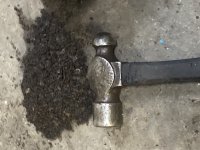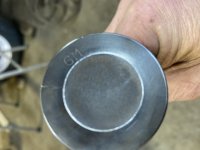Finally put my 1980 Starcraft in the water last weekend. Loaded the family and dogs and went up the lake to a nice beach. Just as we got there the engine overheated. We pulled up on shore and waited until things cooled a bit. I pulled the feed hose from the impeller to thermostat housing and started the engine. Had a good flow of water.
Next I took the thermostat cover off and removed and checked the thermostat, it was seized. I left the thermostat out and we headed back to the docks. Boat ran at 125-130° all the way back. New thermostat ordered but slow getting here. Anyway, this weekend (still no thermostat) my wife and I decided to do a short fishing trip. Boat was running 125-130°. I ran full throttle for a couple minutes and even without the thermostat it overheated.
We anchored the boat did a little fishing while things cooled down. Again I pulled the hose from the impeller to verify water flow and again, good flow. I reattached the hose, started the engine and the temperature dropped to 160° right away.
I have a few thoughts but since this is my first sterndrive, the cooling system is a bit of a mystery to me.
1- thermostat needs to be in place to properly direct flow of water.
2- blockage somewhere
3- airlock in cooling system.
Where should I start? End caps on manifold? Water pump? If the cooling passages are blocked or partially blocked, what’s the best way to clean/flush them out? Can it be done with the boat in the water or should it be on the trailer?
Carb has been rebuilt, new cap, points/condenser, rotor and wires. dwell angle 32° timing 4°BTDC. Fresh oil and fresh fuel. Top speed was 33mph according to GPS.
I really like the boat but the overheating issue makes me Leary of using it.
Next I took the thermostat cover off and removed and checked the thermostat, it was seized. I left the thermostat out and we headed back to the docks. Boat ran at 125-130° all the way back. New thermostat ordered but slow getting here. Anyway, this weekend (still no thermostat) my wife and I decided to do a short fishing trip. Boat was running 125-130°. I ran full throttle for a couple minutes and even without the thermostat it overheated.
We anchored the boat did a little fishing while things cooled down. Again I pulled the hose from the impeller to verify water flow and again, good flow. I reattached the hose, started the engine and the temperature dropped to 160° right away.
I have a few thoughts but since this is my first sterndrive, the cooling system is a bit of a mystery to me.
1- thermostat needs to be in place to properly direct flow of water.
2- blockage somewhere
3- airlock in cooling system.
Where should I start? End caps on manifold? Water pump? If the cooling passages are blocked or partially blocked, what’s the best way to clean/flush them out? Can it be done with the boat in the water or should it be on the trailer?
Carb has been rebuilt, new cap, points/condenser, rotor and wires. dwell angle 32° timing 4°BTDC. Fresh oil and fresh fuel. Top speed was 33mph according to GPS.
I really like the boat but the overheating issue makes me Leary of using it.





















